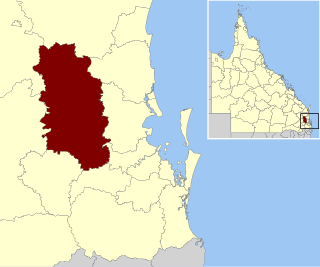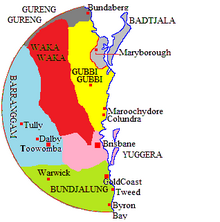Language
Yuggera belongs to the Durubalic subgroup of the Pama–Nyungan languages, and is sometimes treated as the language of the Brisbane area. However, Turrbal is also sometimes used as the name for the Brisbane language or the Yugerra dialects of the Brisbane area. The Australian English word "yakka" (loosely meaning "work", as in "hard yakka") came from the Yuggera language (yaga, "strenuous work").
According to Tom Petrie, who provided several pages listing words and placenames in the languages spoken in the area of Brisbane (Mianjin),yaggaar was the local word for "no". (The word for "no" in Aboriginal languages was often an ethnonymic marker of difference between Aboriginal groups.) Mianjin is a Yuggera/Turrbal word meaning "spike place" or "tulip wood". It was used for the area now covered by Gardens Point and the Brisbane central business district. The Yuggera word for the Aboriginal people of Brisbane was Miguntyun. [13]
Ludwig Leichhardt recorded the name for the land holding area from Gardens Point to Breakfast Creek as Megandsin or Makandschin.
Country
The precise territorial boundaries of the Jagera are not clear. Norman Tindale defined the "Jagara" (Jagera) lands as encompassing the area around the Brisbane River from the Cleveland district west to the dividing range and north to the vicinity of Esk. According to Watson, the "Yugarabul tribe" (Jagera) inhabited the territories from Moreton Bay to Toowoomba to the west, extending almost to Nanango in the northwest. He also describes their territory as "the basins of the Brisbane and Caboolture Rivers" and states that a sub-group of the Yugarabul was the "Turaubul" (Turrbal) people whose territory included the site of the modern city of Brisbane. According to Steele, the territory of the "Yuggera people" (Jagera) extended south to the Logan river, north almost to Caboolture and west to Toowoomba. However, he considered that Turrbal speakers covered much of Brisbane from the Logan river to the Pine river. Ford and Blake state that the Jagera and Turrbal were distinct peoples, the Jagera generally living south of the Brisbane river and the Turrbal mostly living north.
At the time of European settlement, the Jagera people comprised local groups each of which had a specific territory. The European names for the locality groups, sometimes called clans, of the Brisbane area include the Coorpooroo, Chepara, Yerongpan and others.
Jagera territory adjoined that of the Wakka Wakka and the Gubbi Gubbi (also written Kabi Kabi or Gabi Gabi) to the north, and that of the Yugambeh and the Bundjalung people to the south.
Native title
Descendants of both the Jagera (Yugara) and the Turrbal consider themselves traditional custodians of the land over which much of Brisbane is built. Native claim applications were lodged respectively by the Turrbal in 1998 and the Jagera in 2011, and the two separate claims were combined in 2013. In January 2015, Justice Christopher Jessup for the Federal Court of Australia, in Sandy on behalf of the Yugara People v State of Queensland (No 2), rejected the claims on the basis that under traditional law, which was now lacking, none of the claimants would be considered to have such a land right. The decision was appealed before the full bench of the Federal Court, which on 25 July 2017 rejected both appeals, confirming the 2015 decision that native title does not exist in the greater Brisbane area.
An Indigenous land use agreement (ILUA) was signed over the site of the historic 1843 Battle of One Tree Hill, now known as Table Top Mountain, when the warrior Multuggerah from the Ugarapul tribe and a group of men ambushed and won a battle with settlers in the area. The ILUA was signed between Toowoomba City Council and a body representing the "Jagera, Yuggera and Ugarapul people" as the traditional owners of the area, in 2008 ( Ilua 2008 ).
Murri is a demonym for Aboriginal Australians of modern-day Queensland and north-western New South Wales. For some people and organisations, the use of Indigenous language regional terms is an expression of pride in their heritage. The term includes many ethno-linguistic groups within the area, such as the Kamilaroi (Gamilaraay) and Yuggera (Jagera) peoples.

The Kabi Kabi people, also spelt Gubbi Gubbi, Gabi Gabi, and other variants, are an Aboriginal Australian people native to South Eastern Queensland. During the Australian frontier wars of the 19th century, there were several mass killings of Kabi Kabi people by settlers. They are now classified as one of several Murri language groups in Queensland. A 2024 determination granted non-exclusive native title rights over an 365,345-hectare (902,790-acre) area of land and waters on the Sunshine Coast.
The Manbarra, otherwise known as the Wulgurukaba, are Aboriginal Australian people, and the traditional custodians of the Palm Islands, Magnetic Island, and an area of mainland Queensland to the west of Townsville.

The Somerset Region is a local government area located in the West Moreton region of South East Queensland, Australia, western part of Brisbane. The region is centred on the town of Esk, which serves as the council seat. Somerset was created in 2008 from a merger of the shires of Esk and Kilcoy, and is known as the Brisbane Valley, owing to the Brisbane River which courses through the region. However, significant parts of the region lie outside the hydrological Brisbane Valley.
The Turrbal are an Aboriginal Australian people from the area now known as Brisbane. The boundaries of their traditional territory are unclear and linguists are divided over whether they spoke a separate language or a dialect of the Yuggera language. The Turrbal/Yuggera toponym for the central Brisbane area is Meanjin.

The Bundjalung people, also spelled Bunjalung, Badjalang and Bandjalang, are Aboriginal Australians who are the original custodians of a region from around Grafton in northern coastal New South Wales to Beaudesert in south-east Queensland. The region is located approximately 550 kilometres (340 mi) northeast of Sydney and 100 kilometres (62 mi) south of Brisbane that now includes the Bundjalung National Park.

The Flinders Peak Group is an unnamed range of hills located on the northern edge of the Scenic Rim Region, south west of Logan City and south east of the City of Ipswich in South East Queensland, Australia. The summit in the Range is Flinders Peak reaching 680 metres (2,230 ft) above sea level.
Turrbal is an Aboriginal Australian language of the Turrbal people of the Brisbane area of Queensland.
The Battle of One Tree Hill was one of a series of conflicts that took place between European settlers and a group of men of the Jagera and other Aboriginal groups in the Darling Downs area in the colony of Queensland in the 1840s, as part of the Australian frontier wars. It was one in which the settlers were routed by a group of local Aboriginal men under the warrior Multuggerah, a rare event both in its form, as pitched battles between the two groups, and in its outcome.
The Yidiny, are an Aboriginal Australian people in Far North Queensland. Their language is the Yidiny language.

The Yugambeh, also known as the Minyangbal, or Nganduwal, are an Aboriginal Australian people of South East Queensland and the Northern Rivers of New South Wales, their territory lies between the Logan and Tweed rivers. A term for an Aboriginal of the Yugambeh tribe is Mibunn, which is derived from the word for the Wedge-tailed Eagle. Historically, some anthropologists have erroneously referred to them as the Chepara, the term for a first-degree initiate. Archaeological evidence indicates Aboriginal people have occupied the area for tens of thousands of years. By the time European colonisation began, the Yugambeh had a complex network of groups, and kinship. The Yugambeh territory is subdivided among clan groups with each occupying a designated locality, each clan having certain rights and responsibilities in relation to their respective areas.
Lockyer is a rural locality in the Lockyer Valley Region, Queensland, Australia. In the 2021 census, Lockyer had a population of 89 people.
The Djiru, otherwise spelt Jirru, Are an Aboriginal Australian people whose traditional lands are along the coasts of Northern Queensland, mainly the area around Mission Beach.
The Ngugi are an Aboriginal Australian people, one of three Quandamooka peoples, and the traditional inhabitants of Moreton Island.
The Djindubari, also written Jindoobarrie or Joondubarri, are or were an Aboriginal Australian people of southern Queensland, whose traditional lands were located on Bribie Island. They are thought to be a horde or clan of the Undanbi.
The Nunukul, also spelt Noonuccal and known also as Moondjan are an Aboriginal Australian people, one of three Quandamooka peoples, who traditionally lived on Minjerribah, in Moreton Bay Area and in mainland Brisbane regions.
The Yadhaykenu, otherwise known as the Jathaikana or Yadhaigana, are an Australian aboriginal tribe of northern Queensland. The name appears to be an exonym from the Western and Central Torres Strait yadaigal "talkers, chatterers,people who speak a lot".
The Undanbi are an Aboriginal Australian people of southern Queensland. Alternative or clan names include Inabara, Djindubari and Ningy Ningy.
The Birri Gubba people, formerly known as Biria, are an Aboriginal Australian people of the state of Queensland.
The Biyaygiri, also known as Bandjin, were an Aboriginal Australian people of northern Queensland.






